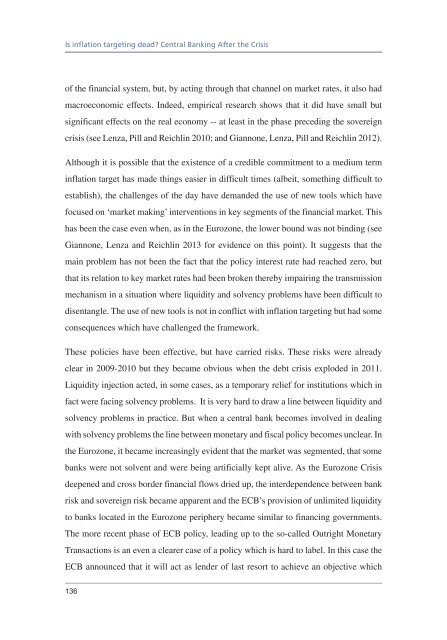You also want an ePaper? Increase the reach of your titles
YUMPU automatically turns print PDFs into web optimized ePapers that Google loves.
Is <strong>inflation</strong> <strong>targeting</strong> dead? Central Banking After the Crisisof the financial system, but, by acting through that channel on market rates, it also hadmacroeconomic effects. Indeed, empirical research shows that it did have small butsignificant effects on the real economy -- at least in the phase preceding the sovereigncrisis (see Lenza, Pill and Reichlin 2010; and Giannone, Lenza, Pill and Reichlin 2012).Although it is possible that the existence of a credible commitment to a medium term<strong>inflation</strong> target has made things easier in difficult times (albeit, something difficult toestablish), the challenges of the day have demanded the use of new tools which havefocused on ‘market making’ interventions in key segments of the financial market. Thishas been the case even when, as in the Eurozone, the lower bound was not binding (seeGiannone, Lenza and Reichlin 2013 for evidence on this point). It suggests that themain problem has not been the fact that the policy interest rate had reached zero, butthat its relation to key market rates had been broken thereby impairing the transmissionmechanism in a situation where liquidity and solvency problems have been difficult todisentangle. The use of new tools is not in conflict with <strong>inflation</strong> <strong>targeting</strong> but had someconsequences which have challenged the framework.These policies have been effective, but have carried risks. These risks were alreadyclear in 2009-2010 but they became obvious when the debt crisis exploded in 2011.Liquidity injection acted, in some cases, as a temporary relief for institutions which infact were facing solvency problems. It is very hard to draw a line between liquidity andsolvency problems in practice. But when a central bank becomes involved in dealingwith solvency problems the line between monetary and fiscal policy becomes unclear. Inthe Eurozone, it became increasingly evident that the market was segmented, that somebanks were not solvent and were being artificially kept alive. As the Eurozone Crisisdeepened and cross border financial flows dried up, the interdependence between bankrisk and sovereign risk became apparent and the ECB’s provision of unlimited liquidityto banks located in the Eurozone periphery became similar to financing governments.The more recent phase of ECB policy, leading up to the so-called Outright MonetaryTransactions is an even a clearer case of a policy which is hard to label. In this case theECB announced that it will act as lender of last resort to achieve an objective which136



